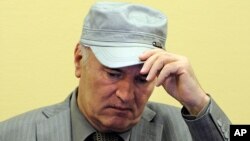Former Bosnian-Serb Army Commander, General Ratko Mladic, is facing 11 charges, including genocide, war crimes and crimes against humanity in a trial that starts Wednesday at a United Nations tribunal in the Hague.
The 70-year-old former commander is accused of ordering the massacre of about 8,000 men and boys outside the Bosnian city of Srebrenica and the bloody siege of Bosnia's capital Sarajevo in the early 1990s.
Mladic, a career military man, trained at the academy of the Yugoslav People's Army in Belgrade. As Yugoslavia began to disintegrate in the early 1990s, he was promoted and took command of all Bosnian Serb military forces when they began fighting for a separate Serb state.
The Srebrenica massacre took place in 1995, when thousands of civilians had gathered in an area designated by the United Nations as a safe haven. Disregarding the U.N. designation, Bosnian Serb troops rounded up as many as 8,000 men and boys and slaughtered them over several days. Mass graves were later found in the surrounding area.
After the war, Mladic returned to Belgrade, where some experts believe he was supported and protected by then-Serbian president Slobodan Milosevic. But after Milosevic was arrested in 2001 and transferred to the Hague tribunal, Mladic went into hiding.
He was arrested in May of last year, almost three years later than Bosnia's wartime political leader Radovan Karadzic. Experts say Mladic must have had support among the Serb military and secret services to avoid arrest for so many years.
The U.N. tribunal indicted him in 1995 along with his former ally Karadzic.
Some information for this report provided by Reuters.
The 70-year-old former commander is accused of ordering the massacre of about 8,000 men and boys outside the Bosnian city of Srebrenica and the bloody siege of Bosnia's capital Sarajevo in the early 1990s.
Mladic, a career military man, trained at the academy of the Yugoslav People's Army in Belgrade. As Yugoslavia began to disintegrate in the early 1990s, he was promoted and took command of all Bosnian Serb military forces when they began fighting for a separate Serb state.
The Srebrenica massacre took place in 1995, when thousands of civilians had gathered in an area designated by the United Nations as a safe haven. Disregarding the U.N. designation, Bosnian Serb troops rounded up as many as 8,000 men and boys and slaughtered them over several days. Mass graves were later found in the surrounding area.
After the war, Mladic returned to Belgrade, where some experts believe he was supported and protected by then-Serbian president Slobodan Milosevic. But after Milosevic was arrested in 2001 and transferred to the Hague tribunal, Mladic went into hiding.
He was arrested in May of last year, almost three years later than Bosnia's wartime political leader Radovan Karadzic. Experts say Mladic must have had support among the Serb military and secret services to avoid arrest for so many years.
The U.N. tribunal indicted him in 1995 along with his former ally Karadzic.
Some information for this report provided by Reuters.
